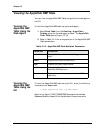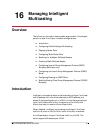
Cajun P550/P880/P882 Switch User Guide
Managing Intelligent Multicasting
16-3
IGMP Snooping IGMP snooping is only supported in layer 3. As IGMP reports are
received by the switch, IGMP sessions are created. Intelligent
multicast sessions are created and the ports on which these reports
are received are added to the appropriate sessions. When the IGMP
session is terminated, the associated intelligent multicast session is
deleted.
* Note: IGMP snooping is only available for VLANs that have an
IGMP interface enabled.
LGMP Server Because layer 2 cannot snoop IGMP messages, it requires layer 3 to
provide the necessary information through a Lucent proprietary
protocol, Lucent Group Membership Protocol (LGMP).
Essentially, LGMP works by having the layer 3 switch re-transmit
received IGMP messages to the layer 2 switches by sending them to
a well known multicast MAC address. The layer 2 switch then
creates multicast sessions, adds clients to those sessions, and
removes sessions dynamically, as if it were directly receiving the
IGMP messages.
If more than one LGMP server is on a VLAN, one server will be
elected as the distributor. Only the distributor disseminates intelligent
multicasting information using LGMP packets.
* Note: IGMP snooping must be enabled for LGMP server
availability. An LGMP server is active only for VLANs
that have an IGMP interface enabled.
Layer 2 Dynamic Intelligent Multicasting
Layer 2 does not support IGMP snooping to dynamically configure
intelligent multicast sessions. Therefore, LGMP client or CGMP
snooping is used to achieve dynamic intelligent multicasting.
LGMP Client An LGMP server disseminates multicast session information using
LGMP. An LGMP client creates multicast sessions, adds clients to
those sessions, and removes sessions dynamically, using the
information sent from the LGMP server.
CGMP Snooping Cisco routers disseminate multicast session information via the
CGMP protocol. The switch has the ability to listen to these
messages and dynamically create multicast sessions, add client ports
to those sessions, and remove sessions.


















